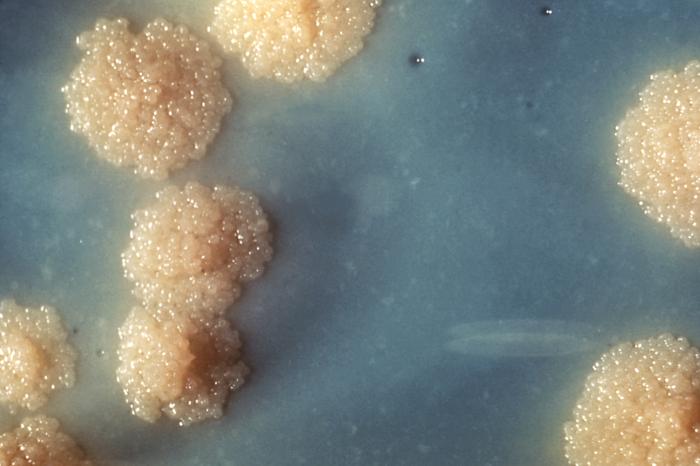Mycobacterium tuberculosis
| Mycobacterium tuberculosis | ||||||||||||||
|---|---|---|---|---|---|---|---|---|---|---|---|---|---|---|
 M. tuberculosis bacterial colonies
| ||||||||||||||
| Scientific classification | ||||||||||||||
| ||||||||||||||
| Binomial name | ||||||||||||||
| Mycobacterium tuberculosis Zopf 1883 |
Editor-In-Chief: C. Michael Gibson, M.S., M.D. [1] ,Assistant Editor-in-Chief: Soumya Sachdeva
Please Take Over This Page and Apply to be Editor-In-Chief for this topic: There can be one or more than one Editor-In-Chief. You may also apply to be an Associate Editor-In-Chief of one of the subtopics below. Please mail us [2] to indicate your interest in serving either as an Editor-In-Chief of the entire topic or as an Associate Editor-In-Chief for a subtopic. Please be sure to attach your CV and or biographical sketch.
Overview
Mycobacterium tuberculosis is the bacterium that causes most cases of tuberculosis.[1] It was first described on March 24, 1882 by Robert Koch, who subsequently received the Nobel Prize in physiology or medicine for this discovery in 1905; the bacterium is also known as Koch's bacillus. The M. tuberculosis genome was sequenced in 1998.[2][3]
Morphology
Slender, straight or slightly curved bacillus with rounded ends, occuring singly, in pairs or in small clumps. These bacilli are acid fast, non sporing, non capsulated and non motile.
Physiology
M. tuberculosis is an obligate aerobe ( weakly Gram-positive mycobacterium, hence Z.N. staining is used). While mycobacteria do not seem to fit the Gram-positive category from an empirical standpoint (i.e. they do not retain the crystal violet stain), they are classified as an acid-fast Gram positive bacterium due to their lack of an outer cell membrane.[1] M. tuberculosis divides every 15 to 20 hours—extremely slowly compared to other bacteria, which tend to have division times measured in minutes (for example, E. coli can divide roughly every 20 minutes). It is a small, rod-like bacillus that can withstand weak disinfectants and can survive in a dry state for weeks.
Diagnosis
Sputum is taken in 3 successive mornings as the number of organisms could be low, and the specimen is treated with 3% KOH or NaOH for liquefaction and decontamination. Gram stain should never be performed as the organism is an "acid-fast bacillus" (AFB), meaning that it retains certain stains after being treated with acidic solution. In the most common staining technique, the Ziehl-Neelsen stain, AFB are stained a bright red, which stands out clearly against a blue background; therefore, the bacteria are sometimes called red snappers.[4] The reason for the acid-fast staining is because of its thick waxy cell wall.[5] The waxy quality of the cell wall is mainly due to the presence of mycolic acids. This waxy cell wall also is responsible for the typical caseous granuloma formation in tuberculosis. The component responsible, trehalose dimycolate, is called the cord factor. A grading system exists for interpretation of the microscopic findings based on the number of organisms obsereved in each field. Acid-fast bacilli can also be visualized by fluorescent microscopy using auramine-rhodamine stain which makes them appear somewhat golden in color. Also, M. tuberculosis is grown on a selective medium known as Lowenstein-Jensen medium which have traditionally been used for this purpose. However, this method is quite slow; as this organism requires 6-8 months to grow which certainly delays reporting of results. A faster results can now be obtained using Middlebrook medium.
See Also
References
- ↑ 1.0 1.1 Ryan KJ; Ray CG (editors) (2004). Sherris Medical Microbiology (4th ed. ed.). McGraw Hill. ISBN 0-8385-8529-9.
- ↑ Cole ST; Brosch R; Parkhill J; et al. (1998). "Deciphering the biology of Mycobacterium tuberculosis from the complete genome sequence". Nature. 393: 537&ndash, 544.
- ↑ Camus JC; Pryor MJ; Medigue C; Cole ST. (148). "Re-annotation of the genome sequence of Mycobacterium tuberculosis H37Rv". Microbiology. 2002: 2967&ndash, 2973.
- ↑ Flowers T (1995). "Quarantining the noncompliant TB patient: catching the "Red Snapper"". Journal of health and hospital law : a publication of the American Academy of Hospital Attorneys of the American Hospital Association. 28 (2): == h ==
95-105. PMID 10141473. line feed character in
|pages=at position 8 (help) - ↑ Madigan, Michael; Martinko, John (editors) (2005). Brock Biology of Microorganisms (11th ed. ed.). Prentice Hall. ISBN 0-13-144329-1.
External links
ca:Mycobacterium tuberculosis de:Mycobacterium tuberculosis fa:میکوباکتریوم توبرکلوزیس ko:결핵균 he:Mycobacterium tuberculosis it:Mycobacterium tuberculosis la:Mycobacterium tuberculosis hu:Mycobacterium tuberculosis nl:Mycobacterium tuberculosis no:Mycobacterium tuberculosis sl:Mycobacterium tuberculosis